I am writing a R code that allows users to select columns from a data and plots histograms for each of them. Hence, I am using a 'for' loop to generate the required number of plots using the ggplot2 library and save them in a single list. But the problem I am facing is that, at every iteration of the 'for' loop, all objects in the list are storing the same plot. Thus, the final output consists of a grid of histograms, labeled differently but depicting the same(last) column.
I understand that this question is quite old and I found the answers on renaming ggplot2 graphs in a for loop and https://stat.ethz.ch/pipermail/r-help/2008-February/154438.html to be a useful starting point.
I have used the standard Swiss Fertility dataset available in R to generate the plots. Here is the code:-
data_ <- swiss
data_ <- na.omit(data_)
u <- c(2, 3, 4, 5, 6)
plotData <- data_[,u]
bw <- 5
plotType <- 'probability'
library(ggplot2)
library(gridExtra)
histogramList <- vector('list', length(u))
if(plotType=='probability')
{
for(i in 1:length(u))
{
indexDataFrame <- data.frame(plotData[,i])
probabilityHistogram <- ggplot(indexDataFrame, aes(x=indexDataFrame[,1]))
histogramList[[i]] <- probabilityHistogram + geom_histogram(aes(y=..density..), binwidth=bw, colour='black', fill='skyblue') + geom_density() + scale_x_continuous(names(plotData)[i]) + opts(legend.position='none')
}
} else
if(plotType=='frequency')
{
for(i in 1:length(u))
{
indexDataFrame <- data.frame(plotData[,i])
probabilityHistogram <- ggplot(indexDataFrame, aes(x=indexDataFrame[,1]))
histogramList[[i]] <- probabilityHistogram + geom_histogram(aes(y=..count..), binwidth=bw, colour='black', fill='skyblue') + geom_density() + scale_x_continuous(names(plotData)[i]) + opts(legend.position='none')
}
}
arg_list <- c(histogramList, list(nrow=3, ncol=2))
#jpeg('histogram', width=1024, height=968)
do.call(grid.arrange, arg_list)
#graphics.off()
I apologize if I have missed an obvious answer to the question in this forum and shall be grateful if you could direct me towards it. I hope my explanation is clear and if not, please let me know about the clarifications required.
Thanks!

